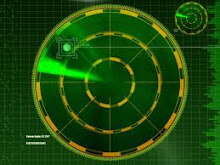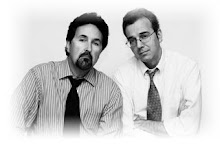By Steve Hammons
The new fact-based fiction movie "The Men Who Stare at Goats" deals with more than meets the eye. Or at least, we see some subjects touched on in quick and sometimes subtle ways that might trigger more thought.
In other scenes, certain topics are dealt with at length or even hit viewers between the eyes with a cinematic sledgehammer.
Incredibly funny parts of the movie are juxtaposed with the troubling, tragic and frightening.
Besides looking at the concepts of the First Earth Battalion and its real-life outside-the-box leader Army Lt. Col. Jim Channon (played by Jeff Bridges), we also get a glimpse at the Vietnam War years and post-Vietnam U.S. Army. These were dark and difficult times in the military and in America.
Yet, the 1960s and ´70s also brought forth the "human potential movement" which included a variety of touchy-feely human encounter activities, experimentation with mind-altering substances, a renewed interest in planet Earth and the natural environment, as well as the value of peace and human love.
From the troubled years after the Vietnam War to the conflicts in Iraq and Afghanistan, moviegoers are asked to consider some basic questions about human beings, the U.S. government and military, and even the forces of good versus "the dark side."
THE HUMAN MIND
The movie, and the book upon which it is based, bring together various subjects in ways that give us the opportunity to reflect further about the larger, deeper and more complex aspects of the real-life material.
For example, the research and operational activities of Project STAR GATE, probably the most widely-known U.S. remote viewing program, was not part of Channon's First Earth Battalion.
However, as indicated by the scene when George Clooney identifies the contents of a small closed box as "a man sitting in a chair," remote viewing did turn out to be a real and valid human skill. Generally speaking, it is a sub-type of ESP, but conducted according to specific and scientific research and operational protocols.
Remote viewing-type skills are related to what we call intuition, gut feelings, instincts and the sixth sense. We probably all have these abilities and can practice and develop them further.
Some of the Project STAR GATE personnel reportedly had quite excellent results at times.
On a separate topic, in the movie an entire Army outpost in Iraq is slipped a mind-altering substance, LSD, via the food and water. In fact, during Army and CIA research of LSD a couple of decades ago, unwitting troops, intelligence officers and civilians were reportedly given this substance to test its effects.
The dangers of this and other mind-altering substances are clearly demonstrated in one troubling and shocking scene. This danger is real and was an unfortunate result for many people in the '60s, '70s and beyond. In fact, certain mind-altering drugs continue to cause severe health, social and legal problems today.
The often valuable research into human consciousness, from the '60s to the present, has been marred in many cases by excess, ignorance, misuse and dangerous behavior. Defining, understanding and separating worthwhile and constructive approaches from stupid and destructive behavior continue to be a challenge now.
VICTORY WITHIN REACH
In the movie, we also get glimpses of the positive potential of human beings, our military and our society.
When the Jeff Bridges character has a near-death experience in Vietnam after being shot, we might wonder about the many reports of similar encounters that have been thoroughly researched and documented. And we might wonder what conclusions can be drawn from them.
The reverence for the Earth through various rituals by some of the characters can also be interpreted as a valid perspective that connects humans with Nature – and helps keep our feet on the ground as well as offering benefits to mental and spiritual health.
Mention in the movie of U.S. military humanitarian operations, peace operations, conflict resolution and similar activities might seem whimsical. However, these activities are now considered important parts of American foreign policy and important missions of the U.S. armed forces.
How fitting that the movie portrays some recent activities in Iraq and Afghanistan as being part of "the dark side."
"The Men Who Stare at Goats" is a funny, thought-provoking and very entertaining movie. It moves along quickly, but not like the rapid-fire pacing of a thriller. It is more like a gentle roller-coaster of humor and tragedy, action and more contemplative moments, with representations of good and evil, light and darkness.
Perhaps most importantly, the movie gives us insight into human nature at its best and worst. The lessons that can be learned from the film, and the stories upon which it is apparently loosely based, are probably more valuable than we might think.
Human consciousness is now changing and evolving in ways that might result in developments so positive that the goals of people like Col. Channon may finally be within reach.
Sunday, November 15, 2009
'Goats’ movie helps us stare at human mind
Sunday, September 13, 2009
‘Integrative perception’ useful in health, media, defense
By Steve Hammons
Human perception is related to a broad range of important endeavors in fields like health, media, national defense and many other areas.
New developments in human perception and consciousness have the potential to help us make progress on these and other fronts.
Perception is personal and also social. It affects families, communities, countries and the international community. Our perception and understanding of ourselves are key in the areas noted above, and in many other ways.
We can take a look at a few examples to see how human perception affects progress in various activities and areas of interest.
HEALTH, HOLLYWOOD, DEFENSE
In the area of health, when well-known health-and-wellness expert and author Andrew Weil, M.D., appeared on CNN’s “Larry King Live” show on Sept. 10, he tried to apply his concepts of “integrative medicine” to the current national debate about health care.
Weil is the founder and director of the Arizona Center for Integrative Medicine at the University of Arizona College of Medicine in Tucson. He also serves as a professor of medicine and public health.
Another example is the new movie "Men Who Stare at Goats" starring George Clooney, Ewan McGregor, Kevin Spacey and Jeff Bridges. This film takes a look at innovative exploration of human consciousness within the U.S. military.
Although the movie and the book upon which it is based are reportedly slanted toward ridicule, many of these actual military and intelligence programs turned out to be quite valid and valuable. People who see the movie might become curious about these important and leading-edge efforts behind the scenes and explore them further.
As Navy Adm. Mike Mullen, current chairman of the Joint Chiefs of Staff, recently noted, the perception of the U.S. internationally is an area of concern, despite recent progress. “Strategic communication” is directly linked to human perception.
In fact, in a paper for the Marine Corps War College some years ago, a Navy SEAL officer studying there noted that “transcendent warfare” may be a useful concept that optimizes forward-leaning research and activities in human perception and consciousness.
INTEGRATIVE MEDICINE
When Dr. Weil was discussing his views of health with King on CNN, he explained some of the ideas of integrative medicine. The concept of integrative medicine is similar to “alternative medicine” or “complementary medicine.”
Weil believes that leading-edge health and wellness methods can be successfully integrated with conventional Western medicine.
In his discussion with King, he suggested that Americans should take more responsibility for their own health and wellness through healthier eating habits, more exercise and other common-sense approaches.
He stated that the over-reliance, in his view, on high-tech and expensive technological and pharmacological methods to treat health problems is unsustainable and not always particularly successful medically.
Weil seemed to be saying that physicians and health care providers, government officials crafting health care proposals and all of us should consider “integrative” viewpoints when thinking about human health and the administration of health care services.
According to the website of the Arizona Center for Integrative Medicine, “Since its inception, the Arizona Center for Integrative Medicine has focused its efforts on three domains: education, clinical care, and research—with the primary emphasis on education.” The site notes that the “Defining Principles of Integrative Medicine” include the following:
1) Patient and practitioner are partners in the healing process.
2) All factors that influence health, wellness, and disease are taken into consideration, including mind, spirit, and community, as well as the body.
3) Appropriate use of both conventional and alternative methods facilitates the body's innate healing response.
4) Effective interventions that are natural and less invasive should be used whenever possible.
5) Integrative medicine neither rejects conventional medicine nor accepts alternative therapies uncritically.
6) Good medicine is based in good science. It is inquiry-driven and open to new paradigms.
7) Alongside the concept of treatment, the broader concepts of health promotion and the prevention of illness are paramount.
8) Practitioners of integrative medicine should exemplify its principles and commit themselves to self-exploration and self-development.
MOVIES, MINDS, INTELLIGENCE
Related to Weil’s views, we might wonder if this integrative perspective or integrative consciousness is applicable in other areas.
Although Weil is now best-known for his work in health, wellness, nutrition and integrative medicine, his 1972 book "The Natural Mind" focused on human consciousness.
This actually dovetails with the movie "Men Who Stare at Goats" and the real-life activities by the U.S. defense and intelligence communities regarding human perception.
Discoveries in the last few decades about human perceptual abilities have found that our instincts, intuition, gut feelings, extrasensory perception (ESP) and “sixth sense” appear to be quite real and valid.
A longstanding effort by the U.S. defense and intelligence communities commonly referred to as Project STAR GATE found that humans have the capability to use “anomalous cognition” or unusual perception to gather intelligence. A specific protocol that was developed to do this came to be called “remote viewing.”
As our understanding about human perception and consciousness improves, it may become apparent that anomalous cognition is really not so unusual after all. Like the study of the health concepts of alternative and complementary medicine, the terms “alternative cognition” and “complementary cognition” might be more appropriate
In fact, taking note of Weil’s perspectives, we might consider the term “integrative cognition” or “integrative perception” to describe using the full range perceptual abilities and capabilities of human consciousness.
This also brings us back to Adm. Mullen’s concerns about important defense challenges in understanding our own internal and external national behavior and how this is perceived overseas.
By examining some of these innovative areas, we can surely make significant progress in many important fields to deal with challenges facing us today.
Monday, August 31, 2009
Movies on UFOs, other worlds help public acclimation?
By Steve Hammons
Recent, current and upcoming movies on stories related to UFOs, off-Earth civilizations and how humans fit into the situation continue to emerge from Hollywood.
A few examples include Aliens in the Attic, a kid-and-family-friendly movie released in July. Planet 51, scheduled to open in November, is an animated film and another one for kids and families.
The dark and introspective District 9 hit theatres in August and seemed to strike a chord with audiences and critics. The Fourth Kind, dealing with abductions of humans, takes the genre to a different level and audiences can check it out beginning this November.
James Cameron’s Avatar, due out in December, is already creating a buzz and promises to be visually exciting and thought-provoking.
And Curmudgeon Films recently obtained the rights to the story of an alleged Area 51 scientist for a movie project tentatively titled S-4: The Incredible True Story of Bob Lazar.
MEDIA AND ACCLIMATION
Are these films and many other creative works helping people prepare psychologically and emotionally for possible significant developments regarding UFOs and encounters with non-human and/or human-related beings from elsewhere?
To explore this question, we do not necessarily need to believe that UFOs and non-human or human-related civilizations are involved here on Earth. However, most people would say this is possible. Some people say it is probable. And others claim that it is a reality – a reality we need to deal with.
For people who are interested, the study of such situations is challenging. There seems to be much speculation and misinformation.
There also appear to be very interesting and well-researched documents, witness testimony and strong circumstantial indications that something along these lines has been going on.
In the mid-1950s, Walt Disney was reportedly approached by the U.S. Air Force and development of a documentary film about visitation of aliens to Earth was allegedly started. However, the plug was pulled on this project.
In subsequent decades, many “fictional” movies and TV shows did emerge that dealt with this topic in various ways. This trend continues now.
People can speculate about if this is an organized acclimation effort to prepare Americans and people around the world for an unconventional situation, or if it is just the creativity, imagination and money-making sense of the movie and TV businesses.
Either way, it is probably true that kids, teens and adults are today more prepared for the possibility or reality of the existence of non-human or human-related extraterrestrials, beings from other dimensions or similar kinds of unconventional scenarios because of movies, TV shows and books on these subjects.
SPECIAL SCENARIOS
Much has been written and discussed about the so-called “Majestic” or “MJ-12” group of experts reportedly formed after the Roswell incident.
Fewer people probably have heard of the alleged U.S. Army Counterintelligence Corps “Interplanetary Phenomenon Unit (IPU),” which, it is claimed, may have been active even before the Roswell case, due to previous intelligence about unconventional situations.
Reports of activities like these could indicate that, as part of dealing with a complex scenario, U.S. leaders realized that the American people would need to be informed and prepared in some way that did not cause undue social or other problems.
Indirect methods such as movies, TV programs, books and other creative endeavors would naturally be resources that could accomplish this. The close bonds formed between Hollywood and the defense community during World War II could have been leveraged to deal with this new challenge.
It will be interesting to see where this goes.
Some of the recent and upcoming movies, like those before them, take a good, hard look not only at “aliens,” but also at ourselves – the human race. This seems to be a necessary part of acclimation about how we might interact with or respond to encounters with others.
The scenario of human contact with more advanced civilizations is often compared to the experience of Native American Indians who encountered the technologically more advanced Europeans beginning in the 1500s until the “conquest” of what is now the western U.S. in the late 1800s.
The Native American Indian tribes, cultures and civilizations suffered quite a bit from this interaction. This is an understatement.
Would this happen to our own human cultures in the face of a technologically-superior race from elsewhere? This is a question that has been carefully considered by many researchers.
BE PREPARED
Preparing ourselves for the possibility or reality of contact like this seems to be wise. Being prepared for possible situations of many kinds is usually a good idea. This can enhance safety and the chances for good outcomes.
Movies, TV, books and other kinds of creative activities have an important part to play in these efforts. They help us explore and consider various possibilities. They prepare us psychologically, emotionally and spiritually, as well as forming common perceptions among us that might be helpful.
Of course, there are other unusual and thought-provoking subjects that may be both related to, and somewhat independent of, the topics of UFOs and visitors.
These include leading-edge thoughts and scientific research into teleportation, time travel, anti-gravity methodologies, advanced human perception, life after death and similar kinds of subjects. Plenty of movies and creative works have tackled these topics too, often with great results.
I like to think that my own two novels, Mission Into Light and the sequel Light’s Hand, as well as the subsequent movie screenplay and two TV pilot scripts based on them, help move the ball forward in these areas.
The books tell the story of the “Joint Reconnaissance Study Group,” a San Diego-based U.S. joint-military service and intelligence team of ten women and men who are tasked with conducting special research and operations. The novels bring readers and viewers into the inner workings of this special activities group as they explore different kinds of mysterious phenomena and the connections between them.
My adaptation of the books to a movie screenplay and a one-hour TV pilot, both closely based on the novels, might also spark interest along the way.
A two-hour TV pilot written by two other screenwriters, based more loosely on my novels, is also a good example of using the TV media to entertain and inform. With the help and guidance from a highly-qualified science advisor, we made sure that our concepts were sound.
Maybe one day these projects will make it to the big or small screen. It would be rewarding to think that these works could contribute not only to the body of worthwhile film and TV projects, but also help somewhat in the larger situations we might face.
Friday, August 14, 2009
Healthy, safe living should be part of national discussion
Monday, July 13, 2009
ESP, remote viewing actually ‘complementary cognition?’
By Steve Hammons
The term “anomalous cognition” has come to mean something similar to what has often been called the “sixth sense.” These concepts are also linked with names for this phenomena such as extrasensory perception (ESP) and remote viewing.
However, is it true that certain kinds of perception are actually “anomalous,” that is, unusual or out of the ordinary?
It may be that the sixth sense is actually a very natural, normal and common kind of perception that we all experience on a regular basis. We may not recognize it as such because we filter those perceptions through our conscious and logical thinking brain.
Or, maybe we just consider these perceptions as hunches, gut feelings, instincts or intuition that we may or may not pay much attention to.
It might be more accurate and constructive to call this kind of perception “alternative cognition” or “complementary cognition.” This is similar to ideas of alternative medicine and complementary medicine.
NORMAL AND NATURAL
We might think of alternative cognition or complementary cognition as just another perceptual resource to go along with our other five senses of sight, hearing, touch, taste and smell as well as our emotions, feelings, dreams, imaginations and thinking brain.
In fact, maybe we will discover that there are more than these modes of perception. Maybe we have the ability to perceive in ways that can be further identified and specified.
There are also joint perceptions that involve using more than one sense or perceptual resource simultaneously. Integrating our sixth sense with the other five and other inner experiences may also be helpful, as well as very natural and normal.
Complementary cognition is probably something all humans, and probably many animals, possess as a natural part of our awareness.
However, this does not mean that all of us utilize this kind of perception in equal measure.
For example, remote viewing refers to some specific methods developed by the U.S. military and intelligence communities in Project STAR GATE during the 1970s, ‘80s and ‘90s. People were selected to be remote viewers in these efforts because they were believed to have better than average or quite good abilities in this area.
These abilities were then scientifically tested, verified, measured and explored by Project STAR GATE personnel.
Are these skills based on elements like personal experiences, training and practice, genetics or psychological traits? All of these factors, and maybe more, probably play a part in the abilities of a particular person.
In addition, the purpose or importance of the alternative or complementary cognition experience might be an important factor. Is it being used as part of an important secret mission, for personal safety and survival, to find a missing child, to catch a dangerous criminal?
Would these situations somehow contribute to the availability or accuracy of complementary cognition experiences compared to a purpose that is less important?
LEADING-EDGE RESOURCE
As we continue to learn more about our sixth sense, ESP, remote viewing, anomalous cognition, alternative/complementary cognition or whatever we might choose to call it, we will probably find answers to these questions.
Scientific research during the Project STAR GATE years resulted in large amounts of useful data that continue to be very helpful in our understanding of this aspect of human consciousness.
In addition to the scientific exploration and measurement of this human ability, it was applied to operational activities involved with U.S. national security, often with significantly successful results.
In fact, a Navy SEAL officer suggested in a research paper for his studies at the Marine Corps War College that remote viewing can be an example of what he called “transcendent warfare.” He suggested that using state-of-the-art and leading-edge emerging knowledge about human consciousness can be an important part of U.S. national security activities.
Subsequent concepts that built on the SEAL officer’s idea of transcendent warfare included the term “transcendent power” which is complementary to diplomatic and military soft power, hard power and what has been called smart power.
Taking the transcendent power idea further, we might discover that it and complementary cognition can be applied to a wide range of efforts and goals including economic prosperity, scientific progress, medical discoveries, human development, international peace operations, resolution of social problems, natural resources conservation and many other important current challenges.
When we begin to understand that alternative and complementary cognition is a natural part being human, we may find that we can make accelerated progress on many levels.
Tuesday, July 7, 2009
Another view of UFO disclosure: Look within
By Steve Hammons
We seem to hear and read quite a bit about "disclosure" in the media nowadays in reference to unconventional and unidentified flying objects (UFOs).
Some people say we must lobby for the release of government-held information so that the American and international public can understand what, if anything, is going on. Are there important new discoveries? Are there threats to the human race? How might the government be handling unconventional scenarios?
Actually, quite a bit of disclosure has already taken place. By doing a reasonable amount of research, any average person can get a very good feel for what may be going on.
Sometimes, things are spelled out quite clearly. Sometimes we have to read between the lines.
GRASSROOTS UNDERSTANDING
There seems to be an assumption that somewhere within the secret groups of, or associated with the U.S. government, there exists a comprehensive understanding of the overall situation when it comes to UFOs, contact with other worlds or dimensions and various kinds of mysterious phenomena.
Although there undoubtedly is classified information that could shed light on some of these topics, specific facts about UFO crashes and other activities may not provide a truly insightful understanding of the larger picture.
In fact, we may not see the forest for the trees. Or, layers of deception could surround apparent facts and situations.
What makes us believe that politicians and those from the military, intelligence and scientific fields have the necessary perspectives to fully understand the real whole situation? Some may and some may not.
Undoubtedly, many or most have tried to do their duty to the best of their ability. Even so, the probable compartmentalization found within secret programs often prevents people – even people on the "inside" – from seeing the bigger and deeper realities involved.
One view is that when more understanding about unconventional situations emerges, it may be through a "grassroots" method. That is, it might not come from the top down – from Washington, D.C. – down to the rest of us. New understanding may come from average people who, through one way or another, make discoveries within themselves about what may be going on.
LARGER ECOSYSTEM
Some researchers have indicated that many unconventional phenomena may be part of our natural environment, part of Nature, part of an ecosystem that is more complex than we may have imagined.
Within this larger ecosystem, humans may not be the most technologically, intellectually or spiritually advanced species involved.
However, the human race may hold some key to ongoing developments in the next stages of an unfolding story. What is our role? Will that role evolve? Are we being oriented and acclimated about this new role our species plays in the larger environment?
Another element to consider is that our situation with regard to unconventional phenomena may be a mystery by nature. That is, even extraterrestrial and/or extra-dimensional visitors may not understand the whole story, let alone U.S. government officials.
This universe or multiverse of ours may be an ever-unfolding mystery. There may be no final answers. There may be no secret government files that will explain it all.
HUMAN CONSCIOUSNESS
Through classified investigations, we may have learned about things like UFOs and exotic physics. These might have led to mind-boggling spacecraft and advanced technologies that remain secret. No doubt, these could be interesting and potentially very helpful.
But is that really where the important answers lie?
Maybe we should also look to the human heart, human kindness, human passion and compassion, human creativity and beauty in music, the arts and other endeavors. Maybe we should look to human decency, to our moral compasses and to human consciousness.
Research into human consciousness, including activities of the U.S. government, has yielded significant results that we have heard plenty about: ESP, remote viewing and similar phenomena.
Maybe this type of research is a good jumping off point for valuable discoveries. Maybe this is the path that will lead us through the mysteries of unconventional phenomena of many kinds, including the UFO phenomena.
And what might we find on that path? Possibly deeper, stranger and even more wonderful mysteries.
Thursday, April 23, 2009
Weird physics: Heaven and Earth, UFOs, consciousness
By Steve Hammons
Some scientific views about our universe now include ideas about multiple dimensions in a "multiverse," bridges or portals between them, fields of "zero point energy" and other fascinating concepts.
How do these newer ideas about ways the universe might be structured and operate compare to more traditional concepts about an afterlife such as "Heaven" or a dimension where we might reside before coming into this life?
What about unusual phenomena such as perceptions of angels, strange lights or UFOs? How do these ideas fit into the overall picture?
And then there is the topic of human consciousness which includes our thinking, creative imaginations, dream states, sensory perception, extrasensory perception (ESP) or "anomalous cognition," prayer and even ideas of links between our consciousness and our DNA.
What are the connections between these many pieces of the puzzle? Can we understand more about the nature of these and other elements around us and within us?
NATURAL REALITIES
In many philosophical and spiritual traditions, a human who has lived a basically good and decent life will go to Heaven or an afterlife of some kind. Some views include the idea of a very unpleasant afterlife for people who have not been a force for good.
Other concepts include ideas of a dimension that serves as a way-station for us as we live one life on Earth, move to another dimension, then begin life again either on Earth or somewhere else.
Some modern physics theories seem to validate the idea that there may be other dimensions that we do not always clearly perceive, but may not be so far away. They may be near, separated from us only by mysterious doorways of some kind.
For example, if we are living our everyday life and for some reason our biological life ends from injury, illness or old age, according to some views we may then promptly move through a tunnel of light to arrive in another dimension fairly quickly. If we come back, it is called a "near-death experience."
Other theories about UFOs, unusual beings and even angels propose that these phenomena involve the ability to slip in and out of our dimension and other dimensions through portals or "wormholes" of some kind.
Combining certain modern scientific views from many fields of study with traditional human beliefs, legends and folklore might help us get a more complete understanding of how the larger Nature is organized and how it operates.
MERGING AND EMERGING
Our beliefs, faith, perceptions, understanding and intelligence also seem to be part of the mix. Human consciousness apparently may have many aspects that we do not fully grasp or routinely use.
Do humans have a "sixth sense" that allows for ESP, telepathy, abilities to glimpse into the future or remember the ancient past? If so, how does it work? Reliable research activities have found strong evidence that people do have the potential for these aspects of human consciousness.
As our understanding of these kinds of subjects improves, we might be able to find more ways to apply this knowledge in our daily lives and in the problems facing human societies on Earth today.
What if the dimensions of our Earth and Heaven were to become more closely linked? What if our loved ones who have passed on and our ancestors became more accessible to us, and we to them?
What if our physical and material dimension on Earth merged somewhat more with a spiritual or cosmic energy-based dimension associated with a transcendent force or field of special "Light" and higher consciousness?
We might wonder if these interesting ideas could actually be real developments evolving and emerging today.
These kinds of research and investigation are not just for scientists and philosophers. We all possess a consciousness that probably has the ability to perceive truth or inaccuracies in various ideas about the Universe and the nature of Nature.
Maybe when more of us have a better feel for these ideas and possible realities we will reach a tipping point that will make some of our hopes and dreams come true.
Monday, April 20, 2009
Former astronaut says Roswell UFO crash true
By Steve Hammons
According to a CNN report April 20, 2009, former astronaut Edgar Mitchell, ScD, PhD, told an audience at the National Press Club in Washington, D.C., that the basic story of a 1947 UFO crash in Roswell, New Mexico, is true. That is, the craft found and recovered was extraterrestrial and involved intelligent beings from elsewhere.
Mitchell was an astronaut on the Apollo 14 mission to the moon in 1971 and he spoke at the National Press Club after the fifth annual X-Conference, an event focused on research involving UFOs.
CNN reported that Mitchell told journalists that there is firm knowledge that extraterrestrial life exists and this information is being held back from the general public in the U.S. and internationally.
Mitchell was raised in Roswell and knew many of the townspeople there. He said they confided to him years later about what they knew, although they had been told to keep the information quiet.
In addition, Mitchell said that about 10 years ago a Navy admiral working for the Joint Chiefs of Staff confirmed to him that a UFO had crashed at Roswell.
Citing the existence of evidence, Mitchell stated, “No, we're not alone.”
ROSWELL AND SECURITY
Mitchell’s statements are not surprising to many researchers and average citizens. Other people might find Mitchell’s comments unsettling because there is also a natural skepticism about claims of UFOs and visitation to Earth by beings from other planets (and/or dimensions).
Claims of this kind coming from a respected and highly-trained person like Mitchell are not easily dismissed.
Information about an alleged crash of a spacecraft piloted by intelligent beings has been around for decades. Books, articles, movies and TV shows have told the story.
However, thinking about the possible reality of such a situation leads to many other questions: What else has happened in the area of UFOs? Have we made contact with other civilizations visiting our planet? Are they friend or foe? Can they help us solve some of the problems of the human race? Why has there been so much secrecy?
In the many accounts and tales about the Roswell incident, it is often noted that in the summer of 1947 the U.S. had just ended a devastating period during World War II. Military secrecy and security had been of the utmost importance during the war.
Some of the first people to learn about the Roswell crash were Army Air Corps (forerunner of the U.S. Air Force) personnel from the nearby Roswell Army Air Field (RAAF), including base intelligence officers.
Despite an intriguing press release that was issued to the media by the RAAF public information officer about a flying saucer being obtained by base officials, higher command quickly dismissed the story as a case of mistaken identity – the debris found was actually a weather balloon-type device, news reporters were told.
Behind the scenes of such a scenario, it would be logical to consider that the Truman administration, Pentagon and intelligence officials would have been shocked and concerned, both about the incident itself and the psychological, emotional and social ramifications for Americans.
ACCLIMATION THEN AND NOW
Are we any more psychologically prepared today than in 1947? Mitchell seems to think so. And so do many other researchers.
Despite the perceived need for robust security reportedly involved in the Roswell incident and subsequent developments, some researchers say that the American public has slowly and steadily received “acclimation” to get used to the idea of extraterrestrial visitors.
Some of this acclimation has allegedly been through the entertainment media and in fictional form as well as the management of information carefully released in indirect ways to the public.
American kids raised on TV and movies since the 1950s have become used to the idea of extraterrestrials coming to Earth. Of course, a real-life situation takes exciting movie adventures to another level and could naturally cause anxiety.
We humans don’t have a great track record getting along with each other, let alone extraterrestrial beings who might be quite different from ourselves.
In addition to strange visitors, the situation could be quite complex. Our understanding of science and Nature, the Universe, spirituality and even the human race itself could be given quite a shock.
If Mitchell is accurate in his statements, then certainly much has been learned since 1947 by people who have been given the task of handling such an important and complex situation. How much information is the public able to understand and accept? Is it good news or bad news, or a mixture of both?
If the Roswell incident was real, as Mitchell claims, what has been going on since that time related to extraterrestrial visitors? Were some of the security measures, scientific research and other activities questionable – either by human officials or visitors?
One thing seems clear, Mitchell has moved the ball forward on acclimation of our society and people internationally about the possibility, or probability, that the human race and Earth are being visited from elsewhere and that we need to prepare ourselves.
Thursday, April 16, 2009
Breakthroughs in human consciousness possible
By Steve Hammons
Right now, all of us are experiencing human consciousness. It is our thinking, feeling and perceptions. It involves us as individuals, families, groups, organizations, communities and nations.
Some people seem to feel that we may be on the verge of breakthroughs of some kind when it comes to human consciousness – a paradigm shift or an emerging new insight.
As we take a look at the world around us, one view about human consciousness is that American society and human culture worldwide seem to be developing in ways that are promising, despite serious problems of various kinds.
At the heart of the situation are human behavior and consciousness, which involve the many aspects of human nature and human societies.
BLENDING AND MERGING
How might a breakthrough or interesting new aspects of human consciousness emerge? What can we do to help the process along?
Research and speculation about consciousness and awareness include many concepts and approaches involving diverse fields. Blending and merging the many factors of our current understanding about consciousness might create a synergy that could be helpful.
Consciousness plays a key part in areas from education to psychology, from scientific research to communication media, from public safety to health care, from economic development to international relations and just about everything in between.
When we take a look at consciousness, it seems that some views and approaches are on the more conventional side and other perspectives may be innovative and outside the box.
We can look at the brain and body to see how they function. Exploring social interactions is another way to look at human psychology and behavior. Our relationship with our physical environment is also a factor to consider.
Some people take a spiritual or metaphysical angle when examining human awareness. Unusual and mysterious phenomena are also areas of interest. Concepts about other dimensions and a "multiverse," near-death experiences (NDEs), extrasensory perception (ESP) and unidentified flying objects (UFOs) spark curiosity.
From many conventional and unconventional viewpoints, a good amount of knowledge has been acquired. Still, there is much that most of us do not fully understand.
MANY PATHS
We can also ask useful questions: What factors affect consciousness? Is there more to it than we generally believe? Does it operate in ways that we fully understand? Can we all learn more about it and help it work for us as individuals and groups?
Using the more conventional as well as leading-edge paths to explore these questions might both yield helpful results.
The biology of the brain, body and neurological system is certainly an important part of human consciousness. Medical researchers are also looking at the influences of our genetics and DNA which seem to promise interesting findings. Mainstream theories in education, psychology, sociology, anthropology and other social sciences also have much to offer.
Pioneering research into unusual and unexplained phenomena, anomalous cognition, enhanced human perception and other unconventional areas of study probably can shed light on the situation as well.
Can the human race make the most of our current understanding and take this knowledge to the next level, whatever that might look like? It might be that this is inevitable and is part of the natural development of humanity.
We might be flowing toward this outcome as if on a river or stream where the waters may be calm or turbulent, but do eventually reach their destination.
Friday, April 10, 2009
Ancient American Indian legends include mystical woman
By Steve Hammons
Does current scientific understanding have connections with ancient accounts of mystical and metaphysical phenomena?
When we hear modern scientists discussing parallel dimensions and mysterious discoveries, can we draw any conclusions about traditional legends of the “First Americans,” Native American Indians?
As we learn about the stories from the Hopi and other tribes regarding visitors from the stars, do we wonder if there is an association with modern-day reports of UFOs?
In 2005, NASA helped promote “Sun-Earth Day,” an observation and celebration that happens on or near the spring equinox each year.
As part of this activity, the NASA Web site featured the section “Ancient Observations, Timeless Knowledge” and a sub-section called “Native American Connections.”
MYSTICAL WOMAN, SACRED PIPE
Among the Native American Indian scholars, astronauts and others featured on the site, a brief biographical overview of Joseph Chasing Horse is included.
The NASA site explains that Chasing Horse is a Lakota and “ambassador to the United Nations for the Lakota Sioux Nations, an ordained Sundance chief and a descendant of the great spiritual leader, Crazy Horse.”
The NASA site also notes that, “With expertise in the fields of educational and environmental issues, he has worked with NASA. As a cross cultural consultant he has assisted JPL (Jet Propulsion Laboratory) in developing Lakota Star Knowledge curriculum. He also serves as liaison between NASA and many traditional Indian communities …”
In addition, the NASA site points out that Chasing Horse, “serves as emissary to … the nineteenth caretaker of the sacred White Buffalo Calf Pipe.”
What is the White Buffalo Calf Pipe, and what meaning does it have for us today?
From other online resources, we can learn about the time long past – said to be 2,000 years ago – when a mystical being came to the Lakota. Her name was White Buffalo Calf Woman.
Other Native American Indian tribes reportedly have similar legends of such a being.
According to Chasing Horse, “They say a cloud came down from the sky, and off of the cloud stepped the white buffalo calf. As it rolled onto the earth, the calf stood up and became this beautiful young woman who was carrying the sacred bundle in her hand.”
“She spent four days among our people and taught them about the sacred bundle, the meaning of it.”
“When she was done teaching all our people, she left the way she came. She went out of the circle, and as she was leaving she turned and told our people that she would return one day for the sacred bundle. And she left the sacred bundle, which we still have to this very day,” Chasing Horse said.
“The sacred bundle is known as the White Buffalo Calf pipe because it was brought by the White Buffalo Calf Woman. It is kept in a sacred place … by a man who is known as the keeper of the White Buffalo Calf pipe.”
Chasing Horse tells us, “When White Buffalo Calf Woman promised to return again, she made some prophecies at that time. One of those prophesies was that the birth of a white buffalo calf would be a sign that it would be near the time when she would return again to purify the world. What she meant by that was that she would bring back harmony again and balance, spiritually.”
CONNECTING THE DOTS
As the human race struggles today with many problems and challenges around the world, we might find valuable information in ancient accounts, such as that of the White Buffalo Calf Woman and the sacred pipe.
Here in North America, we have many direct links to the ancient perceptions of Native American Indian peoples. Not only do we have a vast array of historical literature and tribal stories available, but millions of Americans today have Indian ancestry.
In addition to single-tribe full-blood Indians, many people are a mix of two or more tribes. Other Americans have a diverse blend of European and Indian bloodlines. Black and Hispanic Americans also often have Native American Indian DNA within their genetic backgrounds.
In fact, this reality may be not fully understood because many American families do not even remember those long-ago Indian ancestors far back in the family tree.
But, could greater awareness associated with this situation be emerging now? Is the consciousness that people like Joseph Chasing Horse describes rising in America today?
Research into DNA mapping is really just beginning, as are the connections between our DNA, consciousness and even more unconventional theories about human genetics.
Significant scientific discoveries in many fields seem to be pointing toward unusual and surprising developments that make connections between our modern world and ancient understanding. These connections cross different fields of study. They provide a more cohesive picture derived from joint studies and observations.
They may fit in to a new kind of transcendent awareness about Nature and the reality around us and within us.
As we consider the possibilities of emerging new consciousness and understanding, we might wonder about the ancient Lakota reports of the White Buffalo Calf Woman.
Does she represent the qualities of Nature, Earth and the Universe (or “multiverse”) that we are reconnecting with today?
Will she be returning soon? And if so, how?
Visit the NASA Native American Connections site at: http://sunearthday.nasa.gov/2005/na/
Wednesday, April 8, 2009
Modern science, ancient wisdom now merging
By Steve Hammons
Some of today’s scientists are theorizing that the universe and our everyday reality may not be quite what we think.
These scientists join the ranks of philosophers, theologians and people around the world who have thought about views on heaven and the afterlife, angels, reincarnation and other metaphysical concepts.
The theory that our universe might actually be a “multiverse” seems to be gaining support.
According to these ideas, there may be several or many intersecting dimensions. Our everyday world is one part of this multiverse, according to these perspectives.
Other dimensions may be unseen and difficult for us to perceive, some of the theories claim. At the same time, there may be circumstances when we might become aware of these other environments and influences.
Like gravity, magnetic energy, invisible parts of the light spectrum and other known natural forces, there may also be similar natural dimensions that we cannot always perceive, according to some views.
Do these concepts help us explain things like near-death experiences (NDEs), extrasensory perception (ESP), unidentified flying objects (UFOs) and other unusual phenomena?
PHYSICAL, METAPHYSICAL IN TANDEM
Interestingly, these modern scientific perspectives are consistent with many traditional views and beliefs in cultures around the world.
For example, Native American Indians have traditionally valued the unseen in nature as an important aspect of reality and life.
According to the Oklahoma Historical Society’s Encyclopedia of Oklahoma History & Culture, for the diverse Indian traditions of the people of Oklahoma, “Native logic is guided by the knowledge that the metaphysical and physical forces both operate in life.” And, “physical and metaphysical dimensions work in tandem.”
This view is consistent with many other philosophies around the world. The unseen or spiritual and our everyday reality go hand in hand.
Our ancestors and loved ones may have passed on to one of these other dimensions. And, it is not clear what the connections or pathways are between our world and the theorized afterlife dimension.
How these possible unseen aspects of the universe or multiverse might actually work is currently being explored by physicists, mathematicians and other scholars.
An actual afterlife dimension may not be so far away. It may be closer than we think. Our ancestors and loved ones might be just around the corner or on the other side of some metaphysical door.
Of course, all of us living today will one day learn more about it when we, too, pass on.
Or, perhaps one day there will be greater integration of our world and the possible dimension in which our ancestors and loved ones may now live.
CONSCIOUSNESS AND DIMENSIONS
As we think about these kinds of ideas, the area of human psychology, consciousness and awareness comes into play. How do we, or can we, perceive or understand more about other dimensions, if they exist?
Intellectual logic can probably take us only so far. Then we might have to move to other kinds of perception such as our deeper mind, our unconscious, our intuition, our dreams and visions, and what is sometimes called “anomalous cognition,” which includes a kind of unconventional awareness or understanding.
This is also probably a nonlinear kind of consciousness. In other words, life and reality as well as our deeper mind may not always move in a line from point A to point B to point C. There are also cyclical and circular features as well as more constant forces.
The Oklahoma Historical Society’s Encyclopedia of Oklahoma History & Culture does a pretty good job of describing this kind of perception: “As nonlinear people, Indians are cyclical by nature. Day changing into night is a cycle, the full moon's monthly repetition is another cycle, and the seasons rotate as well.”
“Life itself, then, is a rotation of circles. Indian peoples' concept of time is that their stories, transmitted through the oral tradition, enliven the past, and that prophecies bring the future back to the present in a time continuum. This is Indian reality; this is the thought pattern of Oklahoma traditional Indians. Nonlinear reality is a powerful theme in the Oklahoma Indian experience.”
One of these cycles might include today’s modern scientists who are rediscovering connections between discoveries in physics and the ancient views of traditional peoples.
Maybe this circle or hoop is now being completed. Maybe today’s physicists searching for a primary force such as “zero point energy” will discover what the Great Spirit has created and the first Americans understood.
Maybe this is the path to other dimensions, including the place from where angels, ancestors and loved ones watch over us and protect us.
Saturday, April 4, 2009
Defense budget: Include ‘transcendent warfare’ R&D
By Steve Hammons
When Defense Secretary Robert Gates presents his plans for the Pentagon budget, it could be wise for him to consider modest funding for “transcendent warfare” research and development.
Transcendent warfare – a term used by a Navy SEAL officer in a 2001 research paper at the Marine Corps War College – includes elements of soft power and hard power, potentially enhancing both. We could say that a concept of transcendent power is capable of creating a synergy of superior methods and resources to face future challenges such as, but not limited to, irregular warfare (IW).
SecDef Gates might already be aware of this potential.
When breakthroughs in transcendent warfare took place in the 1970s, ‘80s and ‘90s in Project STAR GATE’s research on human perception, the military services led the way in cooperation with the Defense Intelligence Agency (DIA).
Maybe it is now time for the Defense Department to lead again on transcendent power R&D.
LEGITIMATE DEFENSE EFFORTS
Many Americans find it troubling when public money is wasted on unwise defense spending or obvious fraud and war profiteering. In recent years, concern has increased about these practices – many of which seem dishonorable.
However, war profiteering should always be distinguished from legitimate and valuable defense spending. Modest funding for transcendent warfare seems to fall into the latter category.
What kinds of transcendent power projects might be valuable for our military, and also provide parallel benefits to other important security and safety personnel as well as society as a whole?
First, thorough review and revisiting of Project STAR GATE research and operations seems like a starting point. Up-to-date research and information-gathering on related scientific and practical-application approaches should be included.
In addition, training and education programs should be developed and implemented for a wider range of personnel. This educational effort would focus on concepts underlying enhanced human perception as well as real-world applications.
Additional efforts should be started to expand the potential applications for knowledge gained from Project STAR GATE and related activities that fall into the categories of transcendent warfare and transcendent power.
CREATING SUPPORT
Can support for these kinds of efforts be created within the DoD, intelligence community, Congress, the public, the media and the current administration? We are probably experiencing a normal learning curve about the significant potential that exists in leading-edge and emerging discoveries such as those related to Project STAR GATE and transcendent warfare.
As the U.S. faces a wider variety of internal and global situations, it can be helpful to explore the possibilities associated with advances of sometimes unconventional approaches. This kind of mindset is relevant to irregular warfare and a wide range of other endeavors.
For the American military, continuing irregular and asymmetric conflicts will probably continue for a time in a kind of “warm war” with certain groups.
We may also be called upon to assist in humanitarian operations, peace operations, conflict prevention, alliance-building and other activities that can make good use of transcendent power assets.
At home, our economic innovation, technological development, educational system enhancement, health care reorganization and many other projects can also benefit from leading-edge research related to Project STAR GATE.
Minimal investments in transcendent power R&D could yield optimal benefits for Americans and the international community.
Sunday, March 29, 2009
Transcendent warfare, transcendent power have potential
By Steve Hammons
Despite the current economic, geopolitical, climatic and other disruptions and difficulties, modern human societies still seem to have vast potential to move forward using concepts related to the idea of "transcendent warfare."
The word "warfare" here should not be interpreted in a rigid way that only denotes conflict, killing and destruction.
Rather, transcendent warfare considers different ways of looking at complex situations of many kinds. This approach strives to use emerging discoveries, insights and understanding about human beings and the environments in which we function.
To expand the concept of transcendent warfare and to clarify possible underlying characteristics of certain elements involved with it, we might also use terms like transcendent power, transcendent perspectives, transcendent activities and the like.
SYNERGY AND SUCCESS
An important aspect of the concept of transcendent thinking is the openness to new discoveries, unconventional approaches and innovative methods.
In addition, transcendent approaches merge the unconventional with the conventional. They blend innovation with established methods. Transcendent efforts strive to create a synergy of various elements.
In geopolitical activities, the balanced use of hard power and soft power leads to the enhancement of both methods – and often to more successful results. Transcendent power brings another valuable asset into this mix.
Transcendent understanding, while embracing outside-the-box concepts, stays deeply rooted in tried-and-true fundamentals.
For example, this was the case in the research, development and operational activities of U.S. Government intelligence efforts involving a variety of elements commonly referred to as Project STAR GATE. Standard scientific methods were utilized to measure and verify unconventional human perception and information acquisition. These efforts were also merged with conventional intelligence, defense and security resources and actions.
WIDE APPLICATIONS
Discussions in many diverse fields are now focusing on innovative and creative ideas along with solutions to achieve various worthwhile objectives. In media, education, government, defense, medicine and health care, economics, sciences, engineering, technology, arts, agriculture, natural resources conservation and other activities, transcendent perspectives also can contribute to more effective outcomes.
How can we utilize new insights and even ancient knowledge to move forward now? How can we mix very unconventional situations and out-of-this-world discoveries with rooted down-to-Earth human experience?
These seem to be formidable challenges, similar to the challenge faced by a Navy SEAL officer who attempted to explain in a research report the surprising scientific and intelligence findings from Project STAR GATE.
Since these transcendent viewpoints can include ideas about quantum physics, human biology, human consciousness, mysterious natural phenomena and other factors, we face an interesting situation when trying to make the most of the information at hand.
However, by learning more about the topics and research associated with transcendent activities, the puzzle pieces just might start coming together.
Friday, March 27, 2009
UFOs and public safety: Firefighter manual explains risks
By Steve Hammons
What do public safety officials and the general public have a need to know about possible unidentified flying objects (UFOs)?
One aspect of the phenomena that may be important involves the possible dangers of "close encounters" with these objects, craft or energy anomalies.
According to a 1992 firefighter training manual, "Fire Officer's Guide to Disaster Control," the two main hazards are powerful anomalous energy fields and psychological impacts. The authors of the guide, Charles "Chuck" Bahme and William Kramer, primarily focus on conventional concerns and duties of firefighters and fire agencies throughout most of the book.
In addition, the authors included a chapter titled Disaster Control and UFOs. In a section of the chapter, Adverse Potential of UFOs, the authors go into greater detail about some of these hazards.
Other sections of this chapter provide useful background information for public safety professionals and the public.
PHYSICAL AND PSYCHOLOGICAL
Physical dangers noted in the guide include exposure to radiation, unusual energy fields, beams or rays, according to Bahme and Kramer. These energy fields have been also been associated with disruption of communications, vehicles, aircraft and power grid operations, as well as physical injury, they point out.
Exploring potential psychological impacts of UFO contact, the guide notes that based on past incidents, public panic should be a concern of firefighters and other public safety and public health personnel.
The panic itself can contribute to accidents, injuries, distress and problematic behavior.
In this sense at least, the manual explains that fire services should consider plans to deal with outcomes from apparent UFO incidents, particularly in metropolitan regions.
We might wonder if fire departments and public safety agencies in the Phoenix, Arizona, region had such contingency plans during the March 13, 1997, "Phoenix lights" incident, even though there apparently was no public panic.
Bahme and Kramer note that there are diverse and myriad opinions about what UFOs actually are. We can also speculate that different UFOs could be different kinds of phenomena and from different origins.
The vague situation and apparent or possible secrecy of official U.S. government activities on this subject should not prevent public safety agencies from preparing for possible encounter scenarios, the manual indicates.
CONVENTIONAL AND UNCONVENTIONAL
The authors propose examples of situations that could occur when fire officials face anomalous events such as UFO encounters: Electrical field phenomena could cause firefighters' communication equipment to be disrupted, fire engines and emergency vehicles to malfunction, or portable generators and lights to fail.
In the case of significant public panic or disruption of social stability, as we saw in the exodus of New Orleans police officers during Hurricane Katrina, public safety officers might be concerned about their families and their own safety, possibly leaving fire and police agencies short-handed.
The unusual psychological effects mentioned in the guide could also impact public safety personnel: A hypnotic, paralyzing, disorienting or confusing mental and emotional state could be faced by firefighters, peace officers and others.
Bahme and Kramer point out that it may be up to public safety officers themselves to share information and coordinate an unconventional situation in a UFO encounter scenario.
Although unconventional UFO incidents are the focus of this interesting chapter from "Fire Officer's Guide to Disaster Control," the points made by the authors can also be applied to other common and unusual situations.
And, we might remember that anomalous phenomena that could impact public safety are not limited to real or perceived UFO activity.
In the closing words of the chapter on Disaster Control and UFOs, Bahme and Kramer remind fire service professionals that planning, adequate resources and good leadership are all key in dealing with public safety situations, conventional and unconventional.
Tuesday, March 24, 2009
Transcendent power has public safety applications
By Steve Hammons
The concepts of hard power, soft power, smart power and transcendent power have been used primarily in discussions about the use of military forces and diplomacy in international activities.
However, these ideas can also be applied to a wide range of other fields and endeavors including public safety.
Public safety agencies use hard power every day. Peace officers have guns, pepper spray, handcuffs, lockups and other tools at hand. Firefighters have special trucks and hoses to douse fires with water as well as advanced medical gear for paramedics and emergency medical technicians to help injured or ill people.
At the same time, these kinds of public safety efforts also use soft power such as one-to-one communication, community outreach and safety education programs.
By merging hard power and soft power, these organizations tap into smart power, the balanced use of both methods and resources in appropriate ways and circumstances.
Public safety personnel can also make good use of certain aspects of transcendent power, an idea based on the term “transcendent warfare” which was used by a former Navy SEAL officer in a 2001 graduate-level research report as part of his studies at the Marine Corps War College.
PSYCHOLOGY AND BEHAVIOR
In public safety responses involving hard power and soft power, human behavior is a key element.
For peace officers, situations involving dangerous behavior, unlawful activity or domestic violence all stem from human behavior. Human behavior results from or in tandem with human psychology, perception, awareness and consciousness.
The same could be said about fire officials. They deal with accidents and injuries as well as fires, many of which could have been prevented by safer behavior. Again, behavior flows from human awareness.
Unsafe behavior can be prevented or mitigated. People can be made more aware of situational dangers around them.
Situational awareness by public safety personnel, children and teens, and average adult citizens can benefit from some of the ideas included in transcendent power and transcendent warfare. Safety steps can be implemented ahead of emerging danger. Danger can be anticipated and possibly perceived ahead of time.
How can research, development and operational experiences involving transcendent warfare help in these ways?
When the SEAL officer made reference to the idea of transcendent warfare, he was, in part, referring to advanced research and operational activities of the U.S. military and intelligence communities in the 1970s, ‘80s and ‘90s.
This research into human awareness and cognition found that humans seem to truly have a “sixth sense.” That is, we have the ability to use our intuition, feelings and gut instincts to sense more about various situations and develop information based on these perceptions.
The then-secret R&D and operations of what came to be known as Project STAR GATE used new understanding about the human sixth sense to gather intelligence information for military and intelligence purposes.
USING THE SIXTH SENSE
It has sometimes been said that peace officers can develop “cop instincts.” In other words, they start to get feelings and perceptions about criminal behavior.
Sometimes these perceptions may be based on subtle cues they pick up visually – someone is acting in suspicious or deceptive ways, or something just doesn’t appear as it should be.
However, other times there may be awareness that is not obtained from the normal five senses of sight, hearing, smell, taste or touch. The perception of a sixth sense might come into play, independently or in sync with what the officer may perceive in more conventional ways.
Emergency medical personnel, when assessing a person’s injuries, may see various symptoms and indicators. There may also be an absence of certain obvious injury. This can be the case with internal bleeding, head trauma and other injuries. Can sixth-sense perception, in combination with other tried and true medical assessment methods, help in evaluating a victim’s condition?
When fighting a structure fire, in addition to knowledge about fire’s effects on various building materials, can a firefighter’s sixth sense help anticipate a building’s catastrophic collapse?
In short, can we use our sixth sense to gather intelligence information or understanding about a range of situations that affect public safety in our everyday lives and in the performance of professional duties?
Based on significant research and operational activities conducted by U.S. military and intelligence personnel, the answer seems to be yes.
By learning more about transcendent warfare, Project STAR GATE and similar resources, public safety personnel may be able to use new and advanced knowledge of human awareness and perception to protect the public, enhance their professionalism and help ensure their own survival.
Monday, March 23, 2009
Wounded troops: DARPA project to regrow human tissue enters next phase
By Steve Hammons
Will U.S. troops who have had serious war injuries find new help from ongoing research to regrow damaged human tissue?
According to an announcement March 23, 2009, the U.S. Defense Advanced Research Projects Agency (DARPA) has extended its contract with a Massachusetts biotechnology company for a research program on the regeneration of muscle tissue lost or damaged by traumatic injury.
DARPA’s long-range goal is to discover and optimize the natural regenerative abilities of the human body to heal war injuries experienced by U.S. troops, including injuries involving bone, muscle, nerves and other soft tissue.
What about people who have had limbs amputated? Could whole hands, arms and legs be regrown, similar to the way salamanders and starfish regrow limbs?
RESEARCHERS PURSUE DISCOVERIES
The company involved in the contract, CellThera, is part of the Bioengineering Institute (BEI) of the Worcester Polytechnic Institute (WPI).
A WPI press release notes that DARPA awarded CellThera a one-year $570,000 contract for research into regenerating mammalian muscle tissue. The contract could be extended for a second year. WPI will be a subcontractor for part of the program.
DARPA funded the first phase of the tissue regeneration program beginning in 2006 in a joint effort between CellThera, WPI and associates at Tulane University, the press release stated.
In that phase, the research team was successful in reprogramming mouse and human skin cells to behave more like stem cells, and more able to begin regrowing tissue.
In the next phase of the project, researchers will attempt to “reprogram and engineer cells to replace damaged skeletal muscle and to restore the normal function of that muscle,” according to the WPI press release.
Raymond Page, PhD, serves as principal investigator for WPI's part of the research. Page is an assistant professor in BEI and WPI's Department of Biology and Biotechnology.
In the next phase, George Pins, PhD, associate professor of biomedical engineering at WPI, joins efforts of the project. Pins developed cell-delivery strategies relevant to the program’s goals. Raymond Dunn, MD, will lead another team in the new research phase. Dunn is professor of surgery and cell biology at the University of Massachusetts Medical School and chief of plastic and reconstructive surgery at UMass Memorial Medical Center.
WOUNDED WARRIORS AND BIOLOGY
Many U.S. troops have sustained serious injuries in the wars in Iraq and Afghanistan. These wounds include traumatic and surgical amputations of legs and arms, burns, severe head and face trauma and other significant damage to body tissues.
Although improved body armor has prevented many deaths, as a result many troops survived with injuries so severe that they would have died in earlier wars.
Improvised explosive devices (IEDs) – roadside or vehicle-borne bombs – have been particularly deadly and damaging.
The DARPA-sponsored research may lead to new discoveries and medical applications that can help these seriously injured troops.
Currently, scientists understand much of the biology about how certain creatures regenerate limbs and other tissue. When salamanders and newts lose a limb, they create new "progenitor cells," also called "precursor cells." These cells gather at the site of the injury, forming a "blastema."
The blastema continue to grow and specialize into cells that form the nerves, bones, cartilage, muscles and skin to create a new limb.
For mammals, this ability typically occurs only in the fetal stage. Yet, new research and bioengineering activities have made progress in learning more about these processes.
Will the research soon progress to applications directly to humans? Depending on the progress made studying the genetic, cellular, chemical and other factors involved, human research could begin some day.
If DARPA-funded investigations into this field lead to success in regrowing selected human tissue, or even entire limbs and organs, people and children around the world with injuries, diseases and other significant medical problems could benefit in ways we can hardly imagine.
Thursday, March 19, 2009
Joint competency in transcendent power needed
By Steve Hammons
When Marine Corps Gen. James Mattis addressed the House Armed Services Committee on March 18, 2009, he made some key points that may be worth looking at from the perspective of "transcendent power" and "transcendent warfare."
Mattis is commander of the U.S. Joint Forces Command and his report to the committee included concepts that are applicable more broadly than many people might assume. There may be additional implications, ramifications or elements involved.
He pointed out that the Joint Forces Command is one of 10 combatant commands in the DoD and oversees a force of 1.16 million active duty, National Guard and Army Reserve soldiers, Navy personnel, Air Force personnel and Marines.
One theme of Mattis' presentation to the committee included the ideas involved in irregular warfare (IW). This concept is similar to terminology like unconventional warfare or guerilla warfare, yet there are now more complex and sophisticated considerations involved in IW preparedness and activities.
Mattis stated that a "core competency" in IW is needed by joint forces.
He also mentioned the term "hybrid warfare" which combines IW and more conventional methods. Mattis stated that adversaries may use methods of a "hybrid nature that combine any available irregular or conventional mode of attack, using a blend of primitive, traditional and high-tech weapons and tactics."
"We must have balanced and versatile joint forces ready to accomplish missions across the full spectrum of military operations — from large-scale, conventional warfare to humanitarian assistance and other forms of 'soft' power," he said.
As we delve into the ideas of soft power, smart power and what has been termed transcendent power, we might ask the same question Mattis rhetorically asked: "What capabilities are required?"
CONVENTIONAL AND UNCONVENTIONAL
One key element that Mattis noted was for education and training of joint personnel.
"A trained warrior may perform acceptably in a conventional operation, but irregular and hybrid wars demand highly-educated warriors to prevail," he explained.
Mattis added, "Special emphasis must be placed on human, cultural, language, and cognitive skills. A 'cognitive' warrior knows how to acquire knowledge, process information from multiple sources, and make timely, accurate decisions in complex, ethically challenging and ever-changing environments."
Here is where we might apply lessons learned from research into transcendent warfare. Cognition includes perceiving, thinking and understanding. Analyzing in the context of overall situational awareness and in complex environments is challenging – and necessary.
In these areas, innovative and outside-the-box approaches are useful, or even fundamentally crucial. This is especially true when significant research, development and operational experiences have demonstrated the value of certain methods.
"So, we must be prepared to think the 'unthinkable,' using our study and imagination to help us defeat the enemy," Mattis noted.
Imagination, deep and wide awareness, optimized human perception and other elements of human consciousness are key aspects that can be helpful. Transcendent warfare and transcendent power embrace research and operational successes that utilize all of these factors – and more.
"We must employ to our advantage the power of both inspiration and intimidation, each in the appropriate measure, to confound our enemies," Mattis stated.
Transcendent warfare and transcendent power can accomplish both of these objectives and might also be candidates for core competency by joint forces.
WHOLE GOVERNMENT, WHOLE NATION, WHOLE EARTH
Mattis also told the congressional committee that current and future challenges require "whole-of-government" approaches. He said military personnel must connect with civilian counterparts and create a synergy of effort.
Sharing information is an important element of this approach, he said.
"Essential to a whole-of-government approach for applying all aspects of national and international power is the ability to share information and situational awareness among all partners."
When information and perspectives are appropriately shared, an "interagency common operational picture" is created, Mattis explained.
This seems to take us back to the topics of education, training and communication efforts discussed in regard to competencies in soft power, smart power and irregular warfare activities.
When thinking about the advantages of a whole-of-government viewpoint that Mattis discussed, we might wonder if a whole-of-nation approach would produce even greater benefits. Would there be greater synergy if a more unified and more powerful joint effort involved broader and deeper elements of American society and of other groups and nations?
What additional kinds of resources and assets are out there if we use our intelligence and situational awareness to examine and optimize transcendent power?
Concurrent with ensuring security, what other accomplishments can be achieved by transcendent power in conducting humanitarian activities, implementing peace operations, expanding scientific knowledge, assisting human development, providing for increased prosperity around the world and improving the long-term prospects of the human race on Earth?
These questions deserve answers. And at this time we seem to be well-positioned to begin to comprehend those answers and the methods to get on the path to them.
Developing widespread joint core competency in transcendent warfare may be the first step on the path.
Friday, March 6, 2009
Transcendent power is natural resource for ARPA-E
By Steve Hammons
The new Advanced Research Projects Agency for Energy (ARPA-E) has been allocated $400 million in the stimulus package to conduct research and development on innovations to optimize our energy resources and options.
Part of ARPA-E’s challenge will be technological – identifying, analyzing and funding promising advanced energy technologies and approaches of various kinds.
Another task will be educating and communicating with the American people, the media, the administration, Congress, businesses, other governmental entities and additional stakeholders about ARPA-E’s efforts and directions.
In these fundamental tasks, ARPA-E can make good use of certain aspects of "transcendent power" – a concept that incorporates leading-edge research, emerging discoveries, information acquisition, human awareness and perception, soft-power communication and other components.
JOINT CONCEPTS
The terms transcendent power and smart power have sometimes been used in connection with military, diplomatic and international contexts, including in relation to the ideas of soft power and transcendent warfare.
However, we can also apply the basic concepts of transcendent power and smart power to a wide range of human activities, including those of ARPA-E and the U.S. Department of Energy.
The terms transcendent power and smart power can also refer to smart energy that transcends previous sources, usage and technologies.
As we know, energy security is directly connected to military security, international peace, global economics and human development around the world.
So, applying transcendent warfare, transcendent power and smart power concepts to energy-related challenges (and a variety of other fields) makes sense.
Since transcendent power also refers to the human creativity, knowledge, discovery, education, communication and leading-edge research of many kinds, transcendent power and transcendent energy R&D go hand in hand.
TRANSCENDENT ENERGY
ARPA-E, like its namesakes the Defense Advanced Research Projects Agency (DARPA) and the newly-formed Intelligence Advanced Research Projects Activity (IARPA), will fund shorter-term and longer-view strategic R&D.
Energy Secretary Steven Chu plans to get the ARPA-E staff moving on the distribution of R&D funds to promising projects in renewable energy, biofuels, “smart-grid” technologies, efficiencies, development of advanced batteries and other goals.
In addition to the $400 million for ARPA-E project funding, the stimulus package also includes approximately $43 billion for a variety of technology, power grid and energy efficiency activities.
In the American southwest with its nearly-constant sunshine and vast open spaces, solar power looks promising. In farming regions, use of certain low-cost, high-yield crops and agricultural waste products could be part of biofuel solutions. New products, devices and technologies for vehicles, homes, businesses and industries are also being developed.
Recently, DARPA provided $35 million to the San Diego-based companies SAIC and General Atomics to research and develop the jet fuel JP-8 created from algae.
According to published reports, algae-based jet fuel R&D is a focus for several companies in San Diego as well as a local research consortium, the Scripps Research Institute, the Scripps Institution of Oceanography and University of California San Diego.
R&D into solar, biofuel, algae-based jet fuel and many other activities can all be considered part of transcendent power and transcendent energy in a variety of ways.
As we learn more about the many elements of transcendent power, our understanding of the future potential in the fields of energy, discovery, insight, knowledge and R&D of many kinds may surprise us with the rich possibilities on the horizon.



































































































































































































